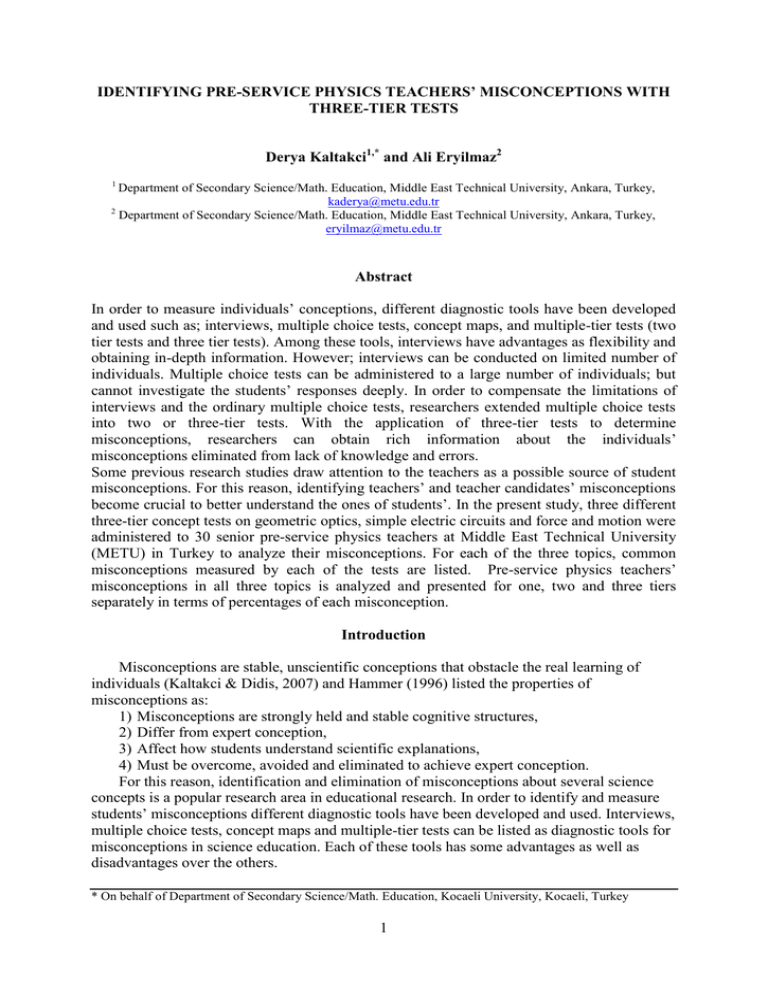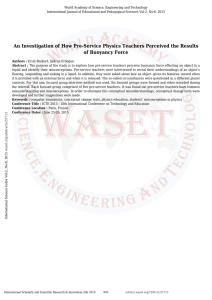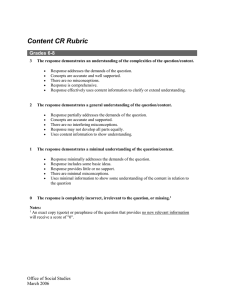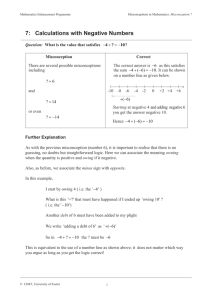Identifying Pre-service Physics Teachers` Misconceptions with Three
advertisement

IDENTIFYING PRE-SERVICE PHYSICS TEACHERS’ MISCONCEPTIONS WITH THREE-TIER TESTS Derya Kaltakci1,* and Ali Eryilmaz2 1 Department of Secondary Science/Math. Education, Middle East Technical University, Ankara, Turkey, kaderya@metu.edu.tr 2 Department of Secondary Science/Math. Education, Middle East Technical University, Ankara, Turkey, eryilmaz@metu.edu.tr Abstract In order to measure individuals’ conceptions, different diagnostic tools have been developed and used such as; interviews, multiple choice tests, concept maps, and multiple-tier tests (two tier tests and three tier tests). Among these tools, interviews have advantages as flexibility and obtaining in-depth information. However; interviews can be conducted on limited number of individuals. Multiple choice tests can be administered to a large number of individuals; but cannot investigate the students’ responses deeply. In order to compensate the limitations of interviews and the ordinary multiple choice tests, researchers extended multiple choice tests into two or three-tier tests. With the application of three-tier tests to determine misconceptions, researchers can obtain rich information about the individuals’ misconceptions eliminated from lack of knowledge and errors. Some previous research studies draw attention to the teachers as a possible source of student misconceptions. For this reason, identifying teachers’ and teacher candidates’ misconceptions become crucial to better understand the ones of students’. In the present study, three different three-tier concept tests on geometric optics, simple electric circuits and force and motion were administered to 30 senior pre-service physics teachers at Middle East Technical University (METU) in Turkey to analyze their misconceptions. For each of the three topics, common misconceptions measured by each of the tests are listed. Pre-service physics teachers’ misconceptions in all three topics is analyzed and presented for one, two and three tiers separately in terms of percentages of each misconception. Introduction Misconceptions are stable, unscientific conceptions that obstacle the real learning of individuals (Kaltakci & Didis, 2007) and Hammer (1996) listed the properties of misconceptions as: 1) Misconceptions are strongly held and stable cognitive structures, 2) Differ from expert conception, 3) Affect how students understand scientific explanations, 4) Must be overcome, avoided and eliminated to achieve expert conception. For this reason, identification and elimination of misconceptions about several science concepts is a popular research area in educational research. In order to identify and measure students’ misconceptions different diagnostic tools have been developed and used. Interviews, multiple choice tests, concept maps and multiple-tier tests can be listed as diagnostic tools for misconceptions in science education. Each of these tools has some advantages as well as disadvantages over the others. * On behalf of Department of Secondary Science/Math. Education, Kocaeli University, Kocaeli, Turkey 1 Interviews provide in-depth information about the students’ cognitive structures and reasoning by its probing and flexibility. Several interviewing techniques have been used such as Piagetian Clinical Interviews (PCI) (Piaget as cited in White & Gunstone, 1992), Interview-About-Instances (IAI) (Osborne & Gilbert, 1979), Interviews-About-Events (IAE) (Osborne & Gilbert, 1980), Prediction-Observation- Explanation (POE) (White & Gunstone, 1992), Individual Demonstration Interview (IDI) (Goldberg & McDermott, 1986, 1987), Teaching Experiment (TE) (Katu, Lunetta, & van den Berg as cited in Komorek & Duit, 2004). However interviews as diagnostic tools have certain disadvantageous as can be conducted on limited number of individuals. For overcoming the disadvantage in interviewing, diagnostic multiple choice tests (Treagust & Haslam as cited in Chen, Lin, & Lin, 2002) that can be immediately scored and applied to a large number of subjects have been used to ascertain students’ conceptions. These tests have been used either following in-depth interviews or alone. However these tests cannot investigate the students’ responses deeply. In literature there exist several examples of multiple choice tests developed by Linke and Venz, Tamir, Trembath (as cited in Chen et al., 2002), and Hestenes, Wells and Swackhamer (1992). Ordinary multiple choice tests with one-tier were criticized in overestimating the students’ wrong answers. Because, some of these wrong answers of students may not be due to students’ misconceptions, but due to lack of knowledge or error. In order to eliminate the limitation of one-tier tests, two-tier tests developed by researchers. Treagust (1985) and Chen et al. (2002) developed two-tier tests with ordinary multiple choice question in the first tier and asking the reasoning in the second tier. Eryilmaz and Surmeli (2002) developed a threetier test about heat and temperature and in their test in addition to the first two tiers they asked students’ confidence about their answers in the third-tier. Afterwards, three tier tests used by many other researchers (Aydin, 2007; Kutluay, 2005; Peşman, 2005; Türker, 2005). The main sources of students’ misconceptions are categorized as the students’ personal experiences, textbooks, language used, and teachers. Since teachers have a crucial influence on students’ learning, an effective pre-service and in-service teacher education process becomes important. For this reason one of the aims of this study is to identify misconceptions of pre-service physics teachers on the topics of “Geometric Optics”, “Force and Motion”, and “Simple Electric Circuits” with three-tier misconception tests to guide effective teacher education attempts in future. The second aim of the study is to give information about threetier misconception tests. Methodology Population and Sample In order to analyze pre-service physics teachers’ misconceptions on three topics: “Geometric Optics”, “Force and Motion”, and “Simple Electric Circuits”, a cross sectional survey study was conducted on 30 senior pre-service physics teachers with 11 girls (37%), 19 boys (63%) at Middle East Technical University (METU) in Turkey. The target population of the study was all senior pre-service physics teachers at METU (approximately 40 students). Instruments Three three-tier misconception tests from literature were used for this study. These are Geometric Optics Misconception Test (GOMT) (Kutluay, 2005), Force and Motion Misconception Test (FMMT) (Turker, 2005), and Simple Electric Circuits Misconception Test (SECMT) (Pesman, 2005). In the development of the three-tier tests, a certain process is followed. Firstly, semistructured interviews with participants similar to the intended sample of the test are done. At 2 this step, common misconceptions on the topic are determined, it gives time to think to the participants, to elaborate on their answers and reasoning, and also gives an opportunity to the researcher to obtain an in depth information. After the interviews, open-ended tests are developed and administered to get greater generalizibility and to create the distracters of the three-tier tests. After analyzing the results of open-ended tests, three tier-tests are developed. In the development process, the interview results and the misconceptions found in literature are also taken into account. All of the instruments are developed for high school students in Turkey. The validity and reliability analysis are done by the researchers. In this present study however, these three tests are administered to pre-service physics teachers who are going to be teachers at high schools in future. The three different three-tier misconception tests were administered during an approximately 30-35 minutes each on different days. Data Analysis In order to analyze misconceptions with three tier tests a descriptive statistical analysis conducted with percentages. For the validity of the test scores three quantitative techniques are used. Firstly, correlation between test scores on the first two tiers and confidence levels on the third tiers are determined to establish construct validity. Since if the test is effective, it is expected that students with higher scores on first two tiers would be more confident about the correctness of their answers (Çataloğlu, 2002). As a second method for validity, factor analysis method is used to determine whether there are one or more clusters of items on the test scores. Thirdly, probabilities of false positive and false negatives are estimated for content validity. False positive is defined as Newtonian response chosen with a non-Newtonian reason. False negatives, on the other hand, are non-Newtonian response that is chosen by Newtonian thinker. False negatives are considered unproblematic and attributed to the carelessness or inattention. According to Halloun and Hestenes (1995), the probability of false negatives should be less that 10%. In the analysis of a three-tier test, if a student chooses incorrect choice in the first tier, then chooses incorrect reasoning in the second tier and sure about the responses in the first two tiers, then the student is considered to have misconception. Other responses are attributed to either errors or lack of knowledge. Results The GOMT, FMMT, and SECMT measures the pure misconceptions of pre-service teachers which are eliminated from lack of knowledge and errors with three tiers. In the first tiers of the tests pre-service teachers are asked about the concepts, in the second tiers they are asked to explain their reasons in the first tiers, and in the third tiers they are asked to what degree they are sure about their given responses in the first two tiers. With this way of measurement, each distracter in the multiple choice test corresponds to a misconception listed previously. Each categorized misconception is determined by the selection of one or more related distracters of several items from the test. However different from a one or two tier test in a three tier test we can determine pure misconceptions. Table 1 shows the misconceptions measured by the GOMT, the items that correspond to these misconceptions, percentage of pre-service teachers having each misconception from the present study, and the percentage of 3 Table 1 Comparison of Misconception Categories for High School Students and Pre-service Teachers for the All Three tiers of GOMT Misconceptions (Items) M1 Light colored objects can be seen in total darkness since they emit light. (1.1.a, 1.2.e, 1.3.a) (12.1.a, 12.2.b, 12.3.a) M2 There will be black rays in the total darkness. (1.1.b, 1.2.a, 1.3.a) (12.1.a, 12.2.e.12.3.a) M3 Eyes can get used to seeing in total darkness. (1.1.c,d, 1.2.b, 1.3.a) (12.1.a, 12.2.d, 12.3.a) M4 Light travels a different distance depending upon whether it is day or night. (2.1.a.,2.2.a,f,g, 2.3.a) (2.1.b, 2.2.b,c,e, 2.3.a) M5 Light is emanating in only one direction from each source, like flash light beams. (3.1.b, 3.2.b, 3.3.a) (5.1.a, 5.2.b, 5.3.a) M6 Shadows of the objects are clearer when the bigger bulb is used as a light source. (3.1.b, 3.2.a, 3.3.a) (4.1.a, 4.2.b, 4.3.a) M7 Shadow belongs only to the non-luminous object and it always looks like the object. (5.1.a,b,d, 5.2.c, 5.3.a) M8 Students claim that there will be no shadow even if a light source and a non- transparent object exist together. (5.1.e, 5.2.a, 5.3.a) (6.1.a, 6.2.e, 6.3.a) M9 In the region of geometrical overlap there would be either lightness (full illumination) or darkness (shadow). They did not consider semi darkness and treated the shadow as the presence of something. (6.1.b, 6.2.b, 6.3.a) (6.1.d, 6.2.a, 6.3.a) M10 Shadow is black color and light is white color. When they overlap, they mix and form the grey color. When the shadow and light overlap, the shadow reduce the brightness of the light. (6.1.c, 6.2.d, 6.3.a) M11 To see an image of any object, it should be inside the front region straight ahead of the mirror. (7.1.c, 7.2.c, 7.3.a) (15.1.b, 15.2.b, 15.3.a) M12 Students think that an image in a plane mirror lies behind the mirror along the line of sight between a viewer and the object. (7.1.a, 7.2.a, 7.3.a) (11.1.a, 11.2.d, 11.3.a) (13.1.b, 13.2.a, 13.3.a) (15.1.b, 15.2.c, 15.3.a) (16.1.b, 16.2.c, e, 16.3.a) M13 An observer sees the object because the observer directs sight lines toward it, with light possibly emitted from the eyes. (7.1.b, 7.2.e, 7.3.a) (11.1.a, 11.2.b, 11.3.a) (15.1.a, 15.2.a,d, 15.3.a) (8.1.a, 8.2.f, 8.3.a) M14 Confuse image formation with shadow formation. In the presence on an illuminant the position and size of the image of an illuminated object depends on the illuminant. (8.1.a, 8.2.g,h, 8.3.a) (8.1.b, 8.2.ab,c,, 8.3.a) (8.1.c, 8.2.c, 8.3.a) (9.1.a, 9.2.a,b,c, 9.3.a) (9.1.b, 9.2.d,e, 9.3.a) M15 The position and size of the image of any object depend on the location of the observer. When the observer retreats size and position of the observer is changed. (10.1.a, 10.2.a,b,c, 10.3.a) (10.1.c, 10.2. k, 10.3a) M16 Image of a black object on the mirror was due to black rays bouncing off the black object. (11.1.a, 11.2.a, 11.3.a) M17 Creating images are an inherent attribute of the silvery mirror material, rather than the product of the reflection process. The students say that “The mirror reflects and so the person sees”. (12.1.a, 12.2.c, 12.3.a) M18 While watching an object its position also shifted as they viewed it from different perspectives. They misunderstand that the absolute position of the object remains the same as an observer moves. (13.1.b, 13.2.a,d, 13.3.a) M19 Image of any object is located right ahead of the observer. (13.1.b, 13.2.b,f, 13.3.a) (16.1.b, 16.2.a,f, 16.3.a) M20 To see him in a dark room, he or she should illuminate the mirror rather than himself. (14.1.b, 14.2.b,c, 14.3.a) AVERAGE 4 % of Preservice (N=30) 4 3 3 0 17 20 3 7 % of High School (N=141) 10 13 23 31 17 30 19 7 10 17 27 30 0 12 73 18 27 18 10 23 7 21 7 7 14 10 10 25 0 13 29 25 12 19 high school students having each misconception from the study of Kutluay (2005). According to the analysis of data the average misconception percentage for pre-service teachers is 12, whereas the average misconception percentage for high school students is 19 for the same test. 73 percent of the pre-service teachers have the misconception labeled as M12 (an image in a plane mirror lies behind the mirror along the line of sight between a viewer and the object) whereas only 18 percent of the high school students have this misconception. None of the pre-service teachers have the misconception labeled as M4, on the other hand 31 percent of the high school students have the same misconception. Table 2 illustrates the analysis of the GOMT results of pre-service teachers for one tier, two tier and three tiers separately. According to the results, if only first tiers of the test are considered an average of 33 percent of misconceptions present for pre-service teachers, if first two tiers of the test considered an average of 15 percent of misconceptions present, and when all three tiers are considered an average of 12 percent of misconceptions present for pre-service teachers. Comparing the analysis for only first tiers and first two tiers a percentage of 18 is predicted to be due to the errors in answers. Also, comparing the analysis for first two tiers and all three tiers a percentage of three is attributed to the lack of knowledge. Table 2 Percentages of the Misconceptions of Pre-service Teachers Considering the Tiers of the GOMT All Three Tiers First Two Tiers Only First Tiers M1 M2 M3 M4 M5 M6 M7 M8 M9 M10 M11 M12 M13 M14 M15 M16 M17 M18 M19 M20 AVERAGE 4 3 3 0 17 20 3 7 10 27 0 73 27 10 7 7 7 10 0 13 12 7 7 3 0 17 20 7 10 13 27 3 80 43 17 10 7 7 10 0 13 43 43 43 7 7 60 40 60 20 20 33 50 43 20 3 0 27 13 30 37 15 33 Similarly Table 3 presents the comparison of misconception categories with percentages for high school students from the study of Turker (2005) and pre-service teachers for the all three tiers of FMMT. The most striking results appear in I4, I5, and AF6 between both samples. According to Table 4, three tier analyses reveal that six percent of the misconceptions are attributed to errors, and three percent is to the lack of knowledge. Table 5 shows the comparison of misconception categories with percentages for high school students from the study of Pesman (2005) and pre-service teachers for the all three tiers of SECMT, and M3 and M11 seems somehow different for the two samples. 5 Table 3 Comparison of Misconception Categories for High School Students and Pre-service Teachers for the All Three tiers of FMMT Misconceptions (Items) I1 Impetus supplied by hit (7.1 a, 7.2 c, 7.3 a/b), (7.1 b, 7.2 a, 7.3 a/b), (16.1 b, 16.2 b, 16.3 a/b), (16.1 c, 16.2 a, 16.3 a/b) I2 Loss/ Recovery of original impetus (5.1 c, 5.2 a, 5.3 a/b), (14.1 a, 14.2 c, 14.3 a/b), (14.1 c, 14.2 b, 14.3 a/b) I3 Impetus dissipation (4.1 a, 4.2 b, 4.3 a/b), (4.1 b, 4.2 c, 4.3 a/b), (6.1 b, 6.2 c, 6.3 a/b) I4 Gradual/ delayed impetus build- up (6.1. c, 6.2 a, 6.3 a/b), (12.1 c, 12.2 a, 12.3 a/b) I5 Circular impetus (3.1 a, 3.2 c, 3.3 a/b), (3.1 b, 3.2 c, 3.3a/b) AF1 Only active agents exert force (2.1 a, 2.2 c, 2.3 a/b), (15.1 a, 15.2 d, 15.3 a/b) AF2 Motion implies active force (2.1 c, 2.2 a, 2.3 a/b), (2.1 d, 2.2 e, 2.3 a/b), (11.1 b, 11.2 b, 11.3 a/b), (11.1 c, 11.2 a, 11.3 a/b) AF4 Velocity proportional to applied force (13.1 a, 13.2 b, 13. 3 a/b) AF6 Force causes acceleration to terminal velocity (13.1 c, 13.2 a, 13.3 a/b) AR1 Greater mass implies greater force (1.1 a, 1.2 c, 1.3 a/b), (1.1 c, 1.2 b, 1.3 a/b), (8.1 b, 8.2 a, 8.3 a/b), (15.1 b, 15.2 a, 15.3 a/b) AR2 Most active agent produces greatest force (8.1 c, 8.2 b, 8.3 a/b), (9.1 b, 9.2 d, 9.3 a/b), (15.1 b, 15.2 b, 15.3 a/b) CI1 Largest force determines motion (8.1 c, 8.2 d, 8.3 a/b), (9.1 b, 9.2 c, 9.3 a/b), (10.1 a, 10.2 b, 10.3 a/b), (10.1 c, 10.2 a, 10.3 a/b) CI2 Force compromise determines motion (5.1 b, 5.2 d, 5.3 a/b), (12.1 b, 12.2 c, 12.3 a/b) CI3 Last force to act determines motion (5.1 a, 5.2 b, 5.3 a/b), (12.1 a, 12.2 d, 12.3 a/b) CF Centrifugal force (2.1 e, 2.2 b, 2.3 a/b), (3.1 d, 3.2 a, 3.3 a/b), (3.1 e, 3.2 a, 3.3 a/b), (11.1 d, 11.2 c, 11.3 a/b) Ob Obstacles exert no force (9.1 c, 9.2 a, 9.3 a/b) AVERAGE % of Preservice (N=30) 23 7 7 0 7 0 27 7 3 3 7 30 10 17 7 23 % of High School (N=188) 18 26 30 33 43 4 24 13 35 29 11 28 10 12 8 17 11 21 Table 5 Comparison of Misconception Categories for High School Students and Pre-service Teachers for the All Three tiers of SECMT Misconceptions (Items) M1 Sink Model (1.1 a, 1.2 a, 1.3 a), (10.1 a, b, 10.2 b, 10.3 a) M2 Attenuation Model (4.1b, c, 4.2 c, 4.3 a) M3 Sharing Current Model (3.1 b, 3.2 c, 3.3.a), (3.1 a, 3.2 c, 3.3.a), (4.1 d, 4.2 c, 4.3 a), (5.1 a, b, 5.2 c, 5.3 a) M4 Clashing Current Model (1.1 b, 1.2 b, 1.3 a), (10.1 a, 10.2 a, 10.3 a) M5 Empirical Rule Model (4.1 b, 4.2 a, 4.3 a), (7.1 b, 7.2 b, 7.3 a), (12.1.a, 12.2.b, 12.3 a) M6 Short Circuit Misconception (8.1 b, 8.2 b, 8.3 a), (8.1 c, 8.2 c, 8.3 a), (10.1 a, 10.2 c, 10.3 a), (12.1 b, 12.2 d, 12.3 a) M7 Power Supply as a Constant Current Source Model (3.1a, c, 3.2 a, 3.3 a), (5.1 c, 5.2 e, 5.3 a), (9.1 d, 9.1 d, 9.3 a) M8 Parallel Circuit Misconception (5.1 a, 5.2 a, 5.3 a) M9 Sequential Reasoning (9.1 a, 9.2 a, 9.3 a), (9.1 c, 9.2 b, 9.3 a) M10 Local Reasoning (2.1 a, 2.2 a, 2.3 a), (5.1 a, 5.2 b, 5.3 a), (12.1 a, 12.2 c, 12.3 a) M11Confusion Between Current Flow and Water Flow (6.1 a, 6.2 a, 6.3 a), (7.1 c, 7.2 a, 7.3 a), (11.1 a, 11.2 b, 11.3 a) AVERAGE 6 % of Preservice (N=30) 3 0 0 10 0 17 7 0 0 10 0 % of High School (N=124) 5 4 11 26 4 16 9 2 4 15 8 4 9 Table 4 Proportions of the Misconceptions of Pre-service Teachers Considering the Tiers of the FMMT Misconceptions All Three Tiers First Two Tiers Only First Tiers I1 I2 I3 I4 I5 AF1 AF2 AF4 AF6 AR1 AR2 CI1 CI2 CI3 CF Ob 23 7 7 0 7 0 27 7 3 3 7 30 10 17 7 23 23 17 10 0 10 0 30 13 7 3 7 37 20 17 10 23 40 30 23 10 20 0 33 13 7 13 30 17 13 17 23 23 AVERAGE 11 14 20 According to Table 6, three tier analyses reveal that one percent of the misconceptions are attributed to errors, and one percent to the lack of knowledge. Table 6 Proportions of the Misconceptions of Pre-service Teachers Considering the Tiers of the SECMT Misconceptions All Three Tiers First Two Tiers Only First Tiers M1 M2 M3 M4 M5 M6 M7 M8 M9 M10 M11 3 0 0 10 0 17 7 0 0 10 0 3 0 0 10 0 23 7 0 0 13 0 30 0 0 0 0 7 10 0 0 13 3 AVERAGE 4 5 6 Conclusion and Discussion Identification of pure misconceptions eliminated from errors and lack of knowledge is crucial. Present study provides the literature with valuable information in two folds: firstly the difference between one, two, tier analysis of three different concepts, secondly the comparison of the misconception categories identified with these three concepts for preservice teachers and the high school students. The results show that analysis of misconceptions with three tier tests eliminates the overestimation of one and two tier tests and disadvantages of the other methods. Also results show that pre-service teachers even after formal education have misconceptions on the three topics like high school students. For this reason teachers should be considered as a source of their students’ misconceptions and a special attention should be given to teacher education process. 7 References Aydin, O. (2007). Assessing tenth grade students’ difficulties about kinematics graphs by a three-tier test. Unpublished Master Thesis,Middle East Technical University, Ankara, Turkey. Cataloglu, E. (2002). Development and Validation of an Achievement Test in Introductory Quantum Mechanics: The Quantum Mechanics Visualization Instrument. Unpublished PhD Thesis, The Pennsylvania State University. Chen, C. C., Lin, H. S., & Lin, M. L. (2002). Developing a two-tier diagnostic instrument to assess high school students’ understanding- the formation of images by plane mirror. Proc. Natl. Sci. Counc. ROC(D), 12(3), 106-121. Eryılmaz, A., & Sürmeli, E. (2002). Üç-aşamalı sorularla öğrencilerin ısı ve sıcaklık konularındaki kavram yanılgılarının ölçülmesi. Proceeding of V. Ulusal Fen Bilimleri ve Matematik Eğitimi Kongresi, Ankara, 110-115. Goldberg, F. M., & McDermott, L. C. (1986). Student difficulties in understanding image formation by a plane mirror. The Physics Teacher, 24(8), 472-481. Goldberg, F. M., & McDermott, L. C. (1987). An investigation of student understanding of real image formed by a converging lens or concave mirror. American Journal of Physics, 55(2), 108-119. Hammer, D. (1996). More than misconceptions: Multiple perspectives on student knowledge and reasoning, and an appropriate role for educational research. American Journal of Physics, 64(10), 1316-1325. Hestenes, D., Wells, M., & Swackhamer, G. (1992). Force Concept Inventory. The Physics Teacher, 30, 141-158. Hestenes, D. & Halloun, I. (1995). Interpreting the force concept inventory. The Physics Teacher, 33, 502-506. Kaltakci, D., & Didis, D. (2007). Identification of pre-service physics teachers’ misconceptions on gravity concept: A study with a 3-tier misconception test. In S. A. Çetin, & İ. Hikmet (Eds.), Proceedings of the American Institute of Physics, USA, 899, 499-500. Komorek, M., & Duit, R. (2004). The teaching experiment as a powerful method to develop and evaluate teaching and learning sequences in the domain of non-linear systems. International Journal of Science Education, 26(5), 619-633. Osborne, R. J., & Gilbert J. K. (1980). A method for investigating concept understanding in science. European Journal of Science Education, 2, 311-321. White, R., & Gunstone, R. (1992). Probing understanding. London: The Falmer Press. Osborne, R. J., & Gilbert J. K. (1979). Investigating student understanding of basic physics concepts using an interview-about-instances approach. Research in Science Education, 16, 40-48. 8




